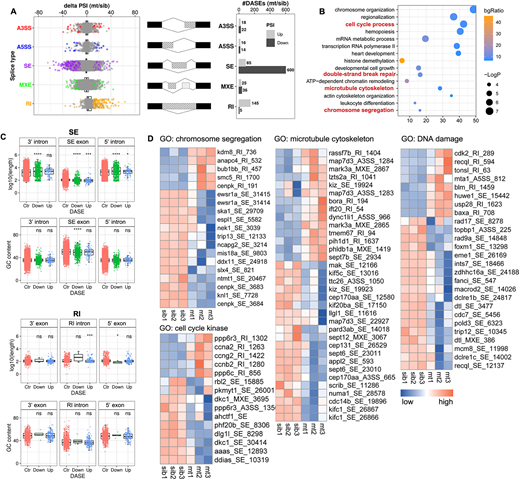Fig. 6 Lack of dhx38 results in abnormal alternative splicing in the cell cycle. (A) Categories of differentially spliced genes based on the changed PSI value in the dhx38 mutants (mt). The percent spliced in index (PSI) indicates the efficiency of splicing a specific exon into the transcript population of a gene. Exons/intron that are constitutively retained in all transcripts and are never skipped have a PSI of 100. Thus, PSI UP indicates exons/introns that are more likely to be retained in the mutants and PSI DOWN indicates exons/introns that more frequently skipped in the mutants. Differential alternative splicing events, DASEs; alternative 3′ splice site, A3SS; alternative 5′ splice site, A5SS; skipped exon, SE; retained intron, RI; mutually exclusive exon, MXE. (B) Gene Ontology (GO) analysis of differentially spliced genes shows that they are significantly enriched in chromatin organization, microtubule cytoskeleton, cell cycle and DNA damage. (C) Sequence lengths and GC content around normal splicing sites and abnormal splicing sites in SE and RI events of dhx38 mutants. In SE events, the length of PSI DOWN group of 3' and 5' introns is longer than the PSI control group, but the length of PSI UP group of introns in RI events is shorter. This suggests that longer introns in SE events and shorter introns in RI events are more likely to respond to the dhx38 loss of function. The PSI DOWN group of GC content around the exon in differential SE events is lower in the dhx38 mutants. This demonstrates that exons with lower GC content are more likely skipped when dhx38 is knocked out. n.s., not significant; *P<0.05; ***P<0.001; ****P<0.0001. (D) Heat maps of differentially spliced genes enriched in chromosome segregation, microtubule cytoskeleton, cell cycle kinase and DNA damage.
Image
Figure Caption
Acknowledgments
This image is the copyrighted work of the attributed author or publisher, and
ZFIN has permission only to display this image to its users.
Additional permissions should be obtained from the applicable author or publisher of the image.
Full text @ Development

